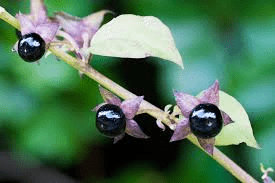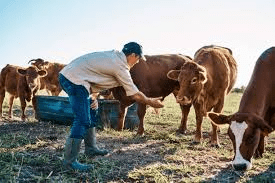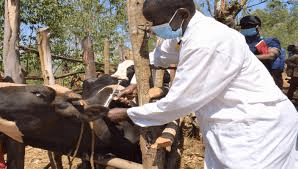Some plants contain toxic substances in that are harmful to ruminants. Plants that contain toxic substances in high amounts are poisonous plants. These toxins that present in these plants cause injuries to ruminant animals when grazed.
These poisonous plants can be found anywhere ruminants graze. The part of the plant eaten, the quantity eaten, and age of the plant and the season of the year are factors that determine how severe the poisoning will be.
Although nitrate poisoning can occur in all animals, but ruminants are particularly susceptible because of the nitrate-reducing ability of rumen microbes (converting nitrate to nitrite). Ruminants also exhibit rapid methaemoglobin formation.
Meanwhile, poisonous plant is one of the causes of livestock health problems all over the world and brings significant economic loss.
Why Ruminants Consume Poisonous Plants
Most cases of plant poisoning in ruminants occur during the dry season when pasture is limited or when areas available for grazing is reduced as occurs in some farming communities.
Ruminants may also consume poisonous plants when their ration is unbalanced and therefore crave for nutrients that are absent from the ration. Grazing ruminants in overgrazed areas can expose animals to eating poisonous plants that they normally would not eat due to shortage of pasture.
Symptoms of Poisoning
The symptoms of plant poisoning depend on the toxic substance in the plant consumed. However, symptoms that common to most conditions are profuse salivation, abdominal pain or colic, bloat or other forms severe digestive discomfort and even sudden death.
Read Also : List of Diseases Ruminant Animals (Livestock) Get from Feeds and Water
Common Poisonous Plants
Common poisonous plants that can be grazed by ruminants include but not limited to Calotropis procera, Erythrophleum Africana, Lasiosyphon krausi, Ipomea asarifolia, Sorghumbicolar, Cassia occidentallis, Jatropa ncurcas, Mannihotesculenta, Cassia tora, Balanites aegyptica, Prosopis obloga.
The toxic components of these plants include toxic nitrates, oxalate, fluroacetate, selenium, etc. Sometimes poisonous plants are mistakenly baled into hay.
Other Sources of Poisoning to Ruminants Metabolic Diseases
Other sources of poisoning do occur when ruminants graze pastures or plants on which herbicides or pesticides have been sprayed.
Most of these herbicides or pesticides contain organophosphates. Poisoning can also occur by ingestion of acaricides used for control of ectoparasites especially when it wrongly constituted or if expired acaricides are used.
What Makes a Plant Poisonous?

The level of poisoning is determined by the amount of the toxic plant consumed, size and species of the animal, general health of the animal, and concentration of the toxin in the plant part.
Symptoms may vary from the inability to perform to fullest potential to more serious manifestations, including slobbering, tremors, lack of coordination, erratic behavior, convulsions, or even sudden death.
The level of toxicity in animals can vary over time due to the irregularity in animal ingestion, but also can be due to the variability in the amount of the toxic compound present in a plant.
The presence of a toxic compound can vary dramatically depending on environmental conditions, management of the pasture, and even can be dependent on the plant part that is eaten (e.g. leaves, stems, roots, fruit, and even seeds). Thus toxicity is the result of many factors that can make diagnosis and determination of the level of seriousness difficult to determine.
For simplicity we separate poisonous plants common to the upper Midwest into three categories:
1. Highly toxic— small amounts (<5% of feed) can result in serious injury/death.
2. Moderately toxic— moderate amounts (>5% – 25%) can result in injury/death.
3. Mildly toxic— under certain environmental or management conditions these plants can be toxic.
When Should I Be Cautious as a Livestock Farmer?

Fortunately the concern about toxicity is often a result of specific situations. Understanding what conditions can lead to plant poisoning can help reduce the risk of harm or death in susceptible herds. If any of these issues apply to you we recommend management practices to alleviate poisonous plants of concern.
1. First grazing in the spring: When animals are put onto pasture for the first time in spring, poisonous plant tissue is young and more palatable. Livestock can feed on these plants at this time, especially if other desirable forage (e.g. forage grasses) hasn’t started to grow.
To avoid this scenario we recommend controlling poisonous plants or not allowing animals into these areas until ample desirable forage is present to reduce the risk of animals feeding on poisonous plants.
2. Limited desirable forage available: When animals are hungry, for any number of reasons, their selectivity decreases and they may eat plants they’d otherwise avoid. Make sure adequate forage is available, especially when poisonous plants are present. This is common especially under drought conditions, in the fall, or when pastures are overgrazed.
3. After an herbicide application: Many weeds are not palatable and are avoided, but after an herbicide application their palatability can increase dramatically.
If poisonous plants are treated with an herbicide we recommend not grazing for at least a 14-day period to avoid this occurrence. Read the product label for more specific recommendations and always follow label directions.
4. After application of nitrogen: Fields with an abundance of nitrate-accumulating plants including pigweeds, common lamb’s quarters, and common ragweed can become toxic after fields are fertilized or following drought conditions.
These common weeds take up excessive nitrogen and convert it to nitrate. If enough of these weeds are eaten this can result in nitrate toxicity. If these weeds are present and consist of at least 20% of the feed in a fertilized field, they should be controlled before allowing animals to graze.
5. Avoid Yard waste/clippings: Many ornamental shrubs and plants are both highly toxic and palatable to livestock. Avoid feeding or dumping yard waste/clippings into pastures or animal holding areas, as this is one of the most common scenarios for livestock poisoning.
6. Animals unfamiliar to a pasture or other area: Animals that are being boarded at a new location are often susceptible to poisoning. When grazing a new area or newly seeded pasture, introduce animals gradually and monitor for any physical changes or change in behavior.
7. Toxic plants in harvested forages: Few options exist for preventing the presence of poisonous plants in purchased hay. To make matters worse it is difficult for animals to avoid poisonous plants when they are dried and mixed with desirable forage. Knowledge of the source of the hay is the only realistic way to prevent this situation.
Prevention/Treatment

Ruminants should be allowed to graze in areas with poisoning plants. It is necessary to identify poisonous plants in areas grazed by ruminants.
Once a ruminant is suspected to have grazed a poisonous plant, the animal should be isolated, given fresh water the animal and stress should be avoided.
Sample of the grazed or consumed material should be kept and the veterinarian called for prompt action. It should be noted that younger animals are more susceptible to poisoning than older animals.
Read Also : 4 Best Investments To Make This Year
